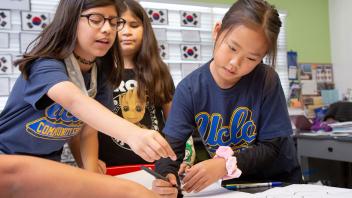What is list-group-label?
List-group-label is a vocabulary and comprehension strategy that engages students in a three-step process to actively organize their understanding of content area vocabulary and concepts. It provides students with a way to recognize the relationships between words and concepts using their prior knowledge about a topic. The list-group-label strategy can be used before and after students read.
Why use list-group-label?
- It helps students organize their understanding of specific vocabulary and concepts.
- It builds on students’ prior knowledge about a topic.
- It actively engages students in learning new vocabulary and content by activating their critical thinking skills.
- It teaches categorizing and labeling skills.
Key Information
Focus
When To Use This Strategy
Appropriate Group Size
How to use list-group-label
1. List
- Introduce a topic from a unit of study or recent read-aloud.
- Have students brainstorm all the words they can think of that are related to that topic.
- Visually display student responses.
- At this point do not critique student responses. Some words may not reflect the main concept, but hopefully students will realize this as they begin grouping the words in the next step.
2. Group
- Divide your class into small groups. Each group will work to cluster the class list of words into subcategories.
- As groups of words emerge, challenge your students to explain their reasoning for placing words together or discarding them.
3. Label
- Invite students to suggest a descriptive title or label for the groups of words they have formed. These labels should relate to their reasons for the grouping.
- If you did the activity with small groups, bring the class together to discuss how they grouped and labeled their words.
Watch a lesson (whole class, grade 2)
Go inside Cathy Doyle’s second grade classroom in Evanston, Illinois to observe her students learning the list-group-label strategy. Cathy builds the lesson around the concept of gardening, based on a recent classroom read-aloud, The Gardener. Joanne Meier, our research director, introduces the strategy and highlights the vocabulary and comprehension skills that list-group-label supports.
Collect resources
Differentiate instruction
For second language learners, students of varying reading skill, and younger learners
- Ask students to return to their lists as they read through the text related to the major concept they brainstormed about. They may find they should add words from their reading or re-label the groups of words they created.
- Encourage students to discuss lists with others outside their initial small group.
- Have students write the lists or type them using a word processing program.
- Provide students with pre-established categories to use to group words.
- Create graphical representations of words in order to help students connect to prior knowledge.
- Ask students to create their own drawings to accompany the words.
Extend the learning
Science
This example shows how the list-group-label strategy can be used with learning about living and non-living earth systems. See earth systems example ›
See the research that supports this strategy
Lenski, S. D., Wham, M. A., & Johns, J. L. (1999). Reading and learning strategies for middle and high school students. Dubuque, IA: Kendall/Hunt.
Rosenbaum, C. (2001). A word map for middle school: A tool for effective vocabulary instruction. Journal of Adolescent & Adult Literacy, 45(1), 44-49.
Tierney, R.J., & Readence, J.E. (2000). Reading strategies and practices: A compendium (5th ed.). Boston: Allyn & Bacon.
Winters, R. (2009). Interactive frames for vocabulary growth and word consciousness. The Reading Teacher, 62(8), 685-690.
Children’s books to use with this strategy

On Beyond Zebra

Why Did the Chicken Cross the Road?

